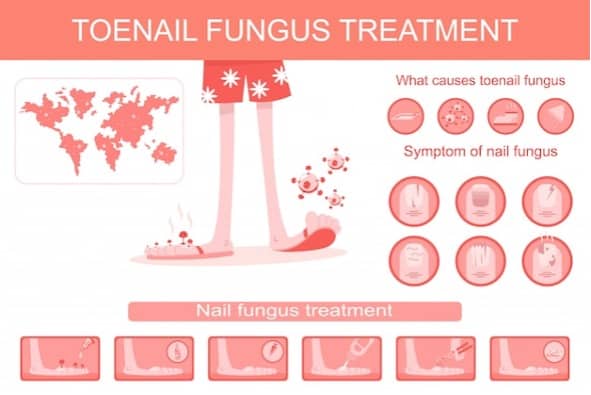
Nail fungus is a common skin condition affecting both men and women. It’s typically found in people who have dry, cracked nails that are also frequently exposed to moisture. It’s caused by several different things, including genetics, certain medications, or even a fungal infection. However, the most common cause of nail fungus is wearing socks or shoes that are not properly ventilated or moisture-resistant. In addition, it can also be caused by a viral infection as well as some underlying medical conditions such as psoriasis or diabetes. While nail fungus can rarely be passed from person to person, it is more commonly spread from one member of your family to the next through personal objects like towels and cosmetics that have been shared between family members for long periods of time.
What Exactly Is Nail Fungus?
Nail fungus is a skin condition caused by a fungus that’s found in warm and moist environments such as the bathroom, shower, and the back of your shoes. This fungus has the ability to overgrow your nails and form a thick, yellow and/or green layer between your nail and the nail bed. There are two types of fungus that can infect your nails. The first is called a “saprophytic fungus,” and this type of fungus infects plants, not people. Saprophytic fungi are often found on the surface of the nail and don’t penetrate the nailbed. Nail onychomycosis is an example of a nail fungus caused by a saprophytic fungus.
Causes of Nail Fungus
A nail fungus is caused by a fungus that grows in moist areas such as bathrooms, showers, and the backs of shoes. If you’re wearing socks or shoes that are not proper moisture-resistant or that have not been cleaned frequently enough, the fungus can grow underneath your nail and cause discoloration and thickening of the nail. Other causes of nail fungus include wearing tight shoes that don’t allow for adequate ventilation, wearing too many socks at once, wearing gloves that don’t allow for proper ventilation, and wearing socks that are not moisture-resistant.
Risk factors for nail fungus
A nail fungus can occur if you have a genetic predisposition to the condition, are prone to frequent hand washing, or are frequently wearing socks or shoes that are not moisture-resistant. Additionally, if you’re taking medications that dry out the skin, like birth control pills, antibiotics, or certain medications for psoriasis, rheumatoid arthritis, or diabetes, you are also at increased risk for developing nail fungus.
Symptoms of nail fungus
Nail fungus can cause the nail to become discolored (usually yellow or green), thick, or brittle. The discoloration of the nail is usually not painful, but the discoloration can occasionally be associated with a mild rash underneath the nail. The common symptoms of nail fungus include yellow or green discoloration of your nails, thickening of the nails, and/or crumbling nails. If you notice any of these symptoms in between your manicures or pedicures, you may have nail fungus.
Home remedies for nail fungus
There are a few inexpensive home remedies that you can try if nail fungus is keeping you from wearing your favorite polish. Boil a bowl of water and drop in a bowl of white vinegar. Allow the bowl of water to sit overnight. In the morning, place your infected nails in the bowl of water for 5 minutes. Make a solution of 2 teaspoons of apple cider vinegar and 2 cups of warm water and place it in a spray bottle. Gently spray your nail surfaces with this solution once every 2 hours. Add a few drops of raw honey to your moisturizer. Apply this daily and your nails will soon become less yellow and thicker.
Treatment for nail fungus
If you’ve tried the above home remedies and your nails are still yellow, discolored, or brittle after a few weeks, you may want to consider seeing a dermatologist or endocrinologist to determine if you have a more serious condition that’s causing the discoloration. If you do have nail fungus, you may be given pills to take or Kerassentials oil to put on your nails to treat it. If you have a more serious medical condition that’s causing your nails to be yellow or brittle, you should also see a doctor. Some underlying medical conditions, like psoriasis, diabetes, HIV, and liver problems, make it more likely that a person will get nail fungus.
Conclusion
Nail fungus is an extremely common condition that mostly affects women. It’s caused by a fungus that likes moist environments and is often spread by wearing ill-ventilated socks or shoes. There are some risk factors that can make you more susceptible to developing nail fungus, such as wearing ill-ventilated socks or shoes, having a genetic predisposition to the condition, and frequent hand washing. If you do develop nail fungus, you may be prescribed oral medications or a topical cream designed to treat the condition. There are also home remedies you can try if you notice any signs of nail fungus. Keeping your nails clean, wearing non-absorbent socks, and washing your hands frequently are all helpful in preventing nail fungus.
Advertise with the mоѕt vіѕіtеd nеwѕ ѕіtе іn Antigua!
We offer fully customizable and flexible digital marketing packages.
Contact us at [email protected]
















